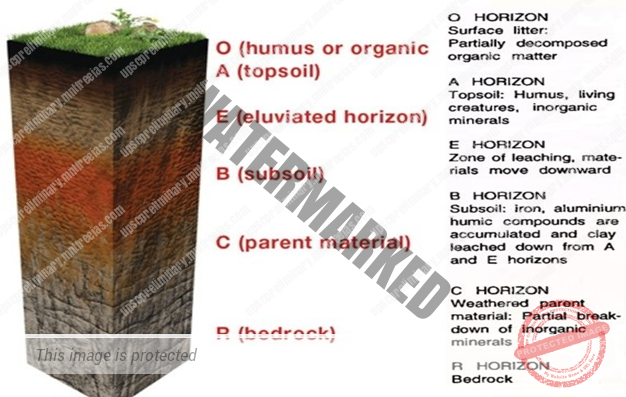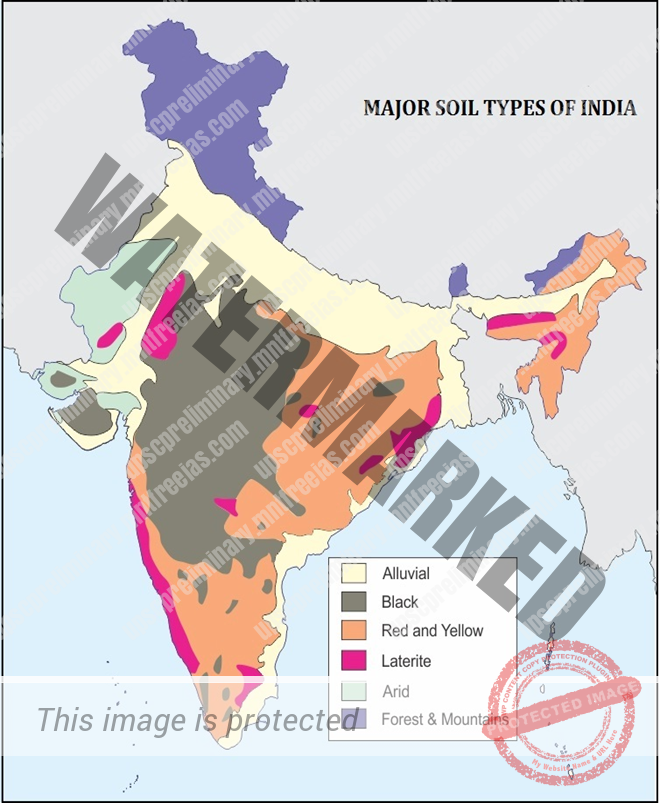- SOIL PROFILE AND SOIL HORIZON
- SOIL CLASSIFICATION
- OTHER CHARACTERISTIC FEATURES
UNIT 5 – SOIL – PART 3
SOIL PROFILE AND SOIL HORIZON:
“…Soil development begins when plants and animals colonize rocks or deposits of rock fragments. Once organic processes start among mineral particles or rock fragments, chemical and physical differences begin to develop from the surface down through the parent material.
If you could dig a massive trench, about 50-100ft vertically downwards into the ground, you will notice that you would have cut through various layers of soil types. A look at the layers from a distance gives one a cross-section view of the ground (beneath the surface) and the kind of soils and rocks it is made up of. This arrangement of layers from the surface down to the parent material is called a Soil Profile…”
Definition:
The soil profile is made up of layers, running parallel to the surface, called Soil Horizons. These layers are distinguished by their physical and chemical properties.
Most soils have three major horizons. These are A Horizon, B Horizon and C Horizon. Aside these three, there are also the O, E and R horizons.
- O-Horizon: The O-horizon is very common to surfaces with lots of vegetative cover. It is the layer made up of organic materials such as Dead Leaves and Surface Organisms, Twigs And Fallen Trees.
- The A-Horizon: The A horizon, immediately below the O horizon, is usually known as the topsoil. It is the top layer soil for many Grasslands and Agricultural Lands. In general, A horizons are dark because they contain decomposed organic matter.
- The E-Horizon: The E horizon is usually lighter in colour, often below the O and A horizons. It is often rich in nutrients that are leached from the top A and O horizons. It has lower clay content and is common in forested lands or areas with high-quality O and A horizons.
- The B-Horizon: Below the E-horizon is the B-horizon, a zone of accumulation, where much of the nutrients removed from the A and E horizons are deposited. It is the layer in which the roots of big trees end. There is a close relationship between the A and B horizons. Translocations, as well as many biological and chemical reactions take place between them.
- The C-Horizon: The C horizon is the weathered parent material from which the soil has developed. This layer is the first stage in the soil formation process and eventually forms the above two layers. The C horizon is also known as
- The R-Horizon: It is the unweathered parent material.
SOIL CLASSIFICATION
India has varied Relief Features, Landforms, Climatic Realms and Vegetation Types. These have contributed to the development of various types of soils in India.
Various classifications adopted to study the Indian Soils:
- In ancient times, soils used to be classified into two main groups:
- Urvara(i.e., fertile), and
- Usara(i.e., sterile)
- In the modern times, soils were classified on the basis of their inherent characteristics and external features such as texture, colour, the slope of land and moisture content in the soil.
- Based on texture, main soil types were identified as sandy, clayey, silty and loam, etc.
- On the basis of colour, they were red, yellow, black, etc.
Since Independence, scientific surveys of soils have been conducted by various agencies.
- On the basis of genesis, colour, composition and location, the soils of India have been classified into:
(i) Alluvial soils
(ii) Black soils
(iii) Red and Yellow soils
(iv) Laterite soils
(v) Arid soils
(vi) Saline soils
(vii) Peaty soils
(viii) Forest soils
ALLUVIAL SOILS
FORMATION: They are mainly derived from the debris brought down from the Himalayas or the silt left out by the retreating sea.
AREAS: Alluvial soils are widespread in the northern plains and the river valleys. Through a narrow corridor in Rajasthan, they extend into the plains of Gujarat. In the Peninsular Region, they are found in deltas of the east coast and in the river valleys. They are the largest soil group covering 46 per cent of the total area.
SOIL TEXTURE: The alluvial soils vary in nature from sandy loam to clay. These soils are loamier and more clayey in the lower and middle Ganga plain and the Brahmaputra valley. The sand content decreases from the west to east.
SOIL COLOUR: The colour of the alluvial soils varies from The Light Grey to Ash Grey depending on the depth of the deposition, the texture of the materials, and the time taken for attaining maturity.
Other Characteristic Features:
- In the Upper and Middle Ganga plain, two different types of alluvial soils have developed, viz. Khadar and Bhangar.
KHADAR: the newer alluvium deposited by floods annually, enriches the soil by depositing Fine Silts, Light Colour, Found Near Riverbeds, porous in nature.
BHANGAR: older alluvium, clayey, darker, has lime nodules called Kankars, found in doabs.
- Alluvial soils of the northern plains are transported soils, therefore lack humus and hence lack nitrogen [That is why we need to use Nitrogenous Fertilisers in the northern plains]. Exception: the Ganga-Brahmaputra delta region is rich in humus.
- These soils lack in Nitrogen, Phosphorus And Humus. However, they are generally rich in potash and lime.
- The soil profile has no stratification.
- Alluvial soils are intensively cultivated.
- In certain areas, these soils are covered with unproductive wind-borne soil called Loess.
LIMITATIONS:
Allow water to sink into lower strata, and
Lack nitrogen (But these soils are capable of fixing nitrogen very rapidly through leguminous crops (peas, beans, cloves etc.)
Suitable Crops:
Wheat, Rice, Maize, Sugarcane, Pulses, Oilseeds, Fruits and Vegetables, Leguminous Crops.
BLACK SOIL
These soils are locally known as the ‘Regur Soil’ or the ‘Black Cotton Soil’. These soils are famous for the cultivation of cotton.
FORMATION: These have mainly formed from the Deccan Trap rocks.
AREAS: These are found in the Deccan trap region. Black soil covers most of the Deccan Plateau which includes parts of:
- Maharashtra,
- Madhya Pradesh,
- Gujarat,
- Andhra Pradesh and some parts of
- Tamil Nadu.
Soil Texture: Black cotton soil (regur soil) is highly argillaceous i.e. clayey. It is deep and impermeable and thus has high water retention capacity.
Soil Colour: These soils are black in colour due to the presence of iron, aluminium compounds and humus.
Other Characteristic Features:
- These soils are rich in minerals and known for their fertility.
These soils swell and become sticky when wet and develop deep wide cracks when dry. This helps in self-aeration, which leads to absorption of nitrogen from atmosphere. Thus, there occurs a kind of ‘self-ploughing’. This aeration and oxidisation to deep levels contributes to maintenance of fertility of these soils. This continued fertility is favourable in the area of low rainfall for cotton cultivation even without irrigation.
- Due to slow absorption and loss of moisture, the black soil retains the moisture for a very long time, which helps the crops, especially; the rain fed ones, to sustain even during the dry season.
MINERAL COMPOSITION:
- Chemically, the black soils are rich in Lime, Iron, Magnesia and Alumina. They also contain potash. But they lack in phosphorous, nitrogen and organic matter.
SUITABLE CROPS:
These soils are highly productive and well suited to the cultivation of Cotton, Pulses, Millets, Linseed, Tobacco, Sugarcane, vegetables, and Citrus Fruits.


